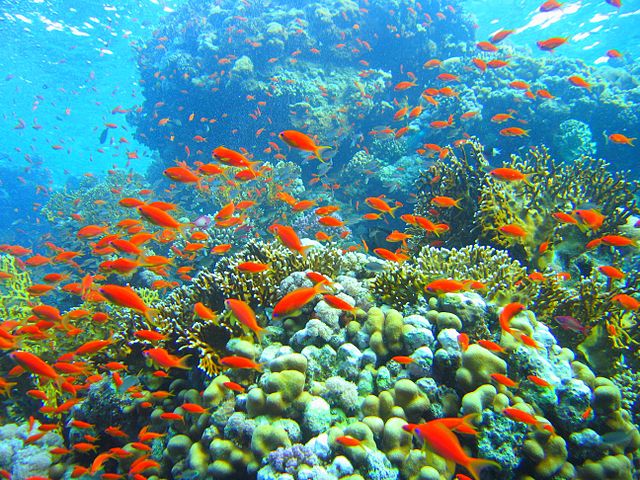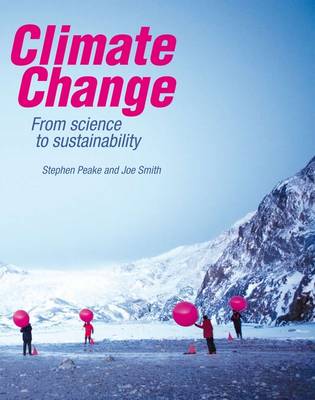By Charles Sheppard
Coral reefs are the most diverse ecosystem in the sea. In some ways they are very robust marine ecosystems, but in other ways, perhaps because of their huge numbers of species, they are very delicate and susceptible to being damaged or killed. On the one hand, healthy reefs are glorious riots of life, and marine scientists have spent several decades unravelling the complicated ways in which they work. On the other hand, at least one third of the world’s reefs have already died — gone for ever in terms of human lifetimes at least — even when the cause of their demise is lifted.
How coral reefs lived and grew right up to the sea surface remained a mystery for years for several reasons. First, where were all their plants? It was known that plants are the world’s food base, yet there were hardly any visible plants, let alone waving fields of them such as the naturalists knew about from their own (mostly cold) Northern shores. The answer is that the main plant base comes from the symbiotic algae living in the cells of reef building corals. This helped answer the second mystery: how could such vibrant reefs live in the nutrient-poor oceans of the tropics? Nutrients, it was known, were needed for plants to grow. But the waters that bathe oceanic reefs in particular were the poorest on Earth in terms of nutrients. The answer was clear once the symbiosis was discovered; there is a very tight cycling of nutrients between the symbiotic components of the coral-algal symbiosis and little ‘leakage’ from the reef into the sea.
There was a third, long running mystery also, namely, how do reefs form? In particular, why do they invariably grow to the surface of the sea from a wide range of depths and, why do they all have rather similar shapes? This was explained in several ways. Firstly it became clear that the Earth’s crust moves, both across oceanic distances over huge time periods, and they move vertically by hundreds of metres. Corals need light (because of their symbiotic algae) so they only live at the contemporary sea level, and the sea level changed hugely over the millennia that corals have lived and made their limestone skeletons. Darwin was the first to deduce this, in particular the importance of growth on subsiding substrates such as volcanoes.

The numerous shapes and kinds of corals, soft corals, and sponges (and many other forms) live together in what has been called a ‘super-symbiosis’ or a ‘super-organism’, terms which, while strictly not true, do give a sense of the intimate linkages that occur between so many of the component groups of species. This may provide one reason why they are, in so many ways, very susceptible to human impacts today. Raised nutrients (e.g. from sewage and shoreline construction) are hugely damaging. Burial of reefs for building on are also fatal to the reefs of course, and, sadly land made by landfill on a reef foundation (something easy to do because reefs are shallow) has a higher economic price when sold for building than the reef did in the first place. Shallow sea and reefs, we might say, become more valuable when they are no longer sea but are converted to expensive, sea-side building land! Eco-nomics and eco-logy have the same root word and should work hand-in-hand, but clearly they don’t, to the detriment of these complex living systems.
Reefs are valuable – but to whom? Reef and beach based tourism forms over half the foreign exchange earnings for many countries. Without reefs to attract tourists, many states would become impoverished; many already are. More importantly (again to whom?) they provide food for huge numbers of coastal dwellers throughout the poorest parts of the world. Not only do fish form the basis for human existence, but so do molluscs, sea cucumbers, octopus… the list is endless. Too many people extracting food from a reef readily collapses the elaborate ecosystem, with the result that there is nothing left for the next year, or the next generation.
Various aspects of climate change are adding to the mix of stresses for reefs. As CO2 builds up, it warms the oceans, and this has killed off countless areas of reef already or at least added an additional stress. When that gas dissolves in the ocean, the water becomes more acidic, again causing damaging effects, in this case reducing the ability to lay down their limestone skeletons. These are not predicted effects – something for the future. We measure it and know that we are already well along that path.
Coral reefs are a canary in the environmental coal mine, showing us, before any other system can perhaps, what we are doing to the earth today. We know enough of their science now to understand this and avert the problems. What we don’t have is the will to do so. It is no longer a problem of science but of sociology and politics.
Charles Sheppard is Professor in the School of Life Sciences at the University of Warwick. His research focuses mainly on community ecology, particularly on ecosystem responses to climate change. He works for a number of UN, Governmental, and aid agencies to advise on topical marine and costal developmental issues. He is the author or editor of 10 books, including The Biology of Coral Reefs (2009) and Coral Reefs: A Very Short Introduction (2014).
The Very Short Introductions (VSI) series combines a small format with authoritative analysis and big ideas for hundreds of topic areas. Written by our expert authors, these books can change the way you think about the things that interest you and are the perfect introduction to subjects you previously knew nothing about. Grow your knowledge with OUPblog and the VSI series every Friday, subscribe to Very Short Introductions articles on the OUPblog via email or RSS, and like Very Short Introductions on Facebook.
Subscribe to the OUPblog via email or RSS.
Subscribe to only earth, environmental, and life sciences articles on the OUPblog via email or RSS.
Image credit: Iolanda reef in Ras Muhammad nature park (Sinai, Egypt), By Mikhail Rogov, CC-BY-SA-3.0 via Wikimedia Commons
The post Coral reef stresses appeared first on OUPblog.




 nstead of watching House episodes all day like a normal person, I spent one of my vacation days making a video about the media practice of greenwashing.
nstead of watching House episodes all day like a normal person, I spent one of my vacation days making a video about the media practice of greenwashing. How should we investigate the notion that humans are changing the climate? Who is best equipped to advise on how to behave in an experiment that we may only get to run once? If I wanted to know about a very complex scientific problem I’d start looking for answers by running the biggest scientific peer review process in human history. The IPCC is exactly that. It was set up to do the best job possible in making sense of an enormously demanding intellectual question: does human activity influence the climate – in the past, present and future?
How should we investigate the notion that humans are changing the climate? Who is best equipped to advise on how to behave in an experiment that we may only get to run once? If I wanted to know about a very complex scientific problem I’d start looking for answers by running the biggest scientific peer review process in human history. The IPCC is exactly that. It was set up to do the best job possible in making sense of an enormously demanding intellectual question: does human activity influence the climate – in the past, present and future?
According to the world’s only remaining viable encyclopedia, greenwashing is the “practice of companies disingenuously spinning their products and policies as environmentally friendly.”
I’m interested in the graphic design motifs that seem to pop up whenever a product wants to advertise itself as Good for the Environment. I was inspired by my hilarious friend Gus’s Media Show episode on greenwashing, and I started thinking about all the sans-serif fonts and burlap lining the shelves of my local organic grocery store.*
This is my first video, and I was a bit nervous. I used iMovie to do the editing, and I slapped the whole thing together in an afternoon with the help of some coffee and a misplaced sense of social justice.
I’d like to do more of this. If you guys have any suggestions for other ornery Librarian Avenger topics, I’d love to hear them.
* I live in San Francisco. I patronize an organic grocery store. I don’t own a car or a tv. Live the stereotype!
** That’s Sister Rosetta Tharpe playing in the background, who is the boss of you.